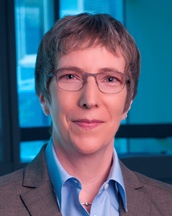Precise Polyethylenes that Control Nanoscale Morphologies & Properties
Karen Winey
University of Pennsylvania, USA
3:30pm - October 19, 2017 - ETLC 1-001
Abstract:
Acid- and ion-containing polymers have specific interactions that produce both acid- or ion-rich aggregates arranged in hierarchical nanoscale morphologies and remarkable bulk properties. Untangling the correlations between the primary structure of such associating polymers and their morphologies and properties has long been a challenge in polymer physics, because most acid- and ion-containing polymers have random sequences of polar and non-polar monomeric units. New synthetic methods increasingly produce polymers with greater molecular precision that provide greater uniformity of and control over the hierarchical morphologies and even yield new morphologies. Specifically, we have studied a series of precise polyethylenes synthesized by acyclic diene metathesis (ADMET) chemistry that have functional groups evenly spaced along linear polyethylenes. We have established design rules connecting these precise polymers to particular hierarchical morphologies and have discovered a variety of new morphologies. For example, when the alkyl spacers in a precise polyethylene are long enough, the polymers assembly into a layered morphology. Using a combination of experimental tools as well as atomistic molecular dynamics simulations, we determined that the polymers make tight conformational turns to produce acid-rich layers that are transverse to the lamellae. This new morphology could be advantageous for controlling transport. The mechanical properties of these precise polyethylenes have three distinct responses, including remarkable strain hardening that corresponds to the onset of an anisotropic layered morphology. Finally, we have recently demonstrated that nearly precise polymers have similar morphologies, which suggests that an even wider range of synthetic strategies can be used to achieve these properties.
Biography:
 Karen I. Winey is Department Chair, Professor and TowerBrook Foundation Faculty Fellow of Materials Science and Engineering at the University of Pennsylvania with a secondary appointment in Chemical and Biomolecular Engineering. Prof. Winey characterizes and manipulates nanoscale morphologies in various ionomers and associating polymers to discover materials with advanced mechanical and transport properties. In particular, she has quantitatively reconciled scattering, imaging and spectroscopic data to describe the morphologies in styrene-based ionomers and discovered new morphologies in several acid-containing precise polyethylenes. Winey also designs and fabricates polymer nanocomposites to understand and improve their mechanical, thermal, and electrical properties, which includes a novel method for extracting the contact resistance in nanowire-based transparent conductors. Polymer diffusion in the presence of nanoparticles and other types of nanoconfinement is currently an active area of interest. In both research areas, she couples experimental studies with simulation and theory, either within her group or with collaborators.
Karen I. Winey is Department Chair, Professor and TowerBrook Foundation Faculty Fellow of Materials Science and Engineering at the University of Pennsylvania with a secondary appointment in Chemical and Biomolecular Engineering. Prof. Winey characterizes and manipulates nanoscale morphologies in various ionomers and associating polymers to discover materials with advanced mechanical and transport properties. In particular, she has quantitatively reconciled scattering, imaging and spectroscopic data to describe the morphologies in styrene-based ionomers and discovered new morphologies in several acid-containing precise polyethylenes. Winey also designs and fabricates polymer nanocomposites to understand and improve their mechanical, thermal, and electrical properties, which includes a novel method for extracting the contact resistance in nanowire-based transparent conductors. Polymer diffusion in the presence of nanoparticles and other types of nanoconfinement is currently an active area of interest. In both research areas, she couples experimental studies with simulation and theory, either within her group or with collaborators.
Winey received her B.S. from Cornell University in materials science and engineering and her Ph.D. in polymer science and engineering from the University of Massachusetts, Amherst with Ned Thomas as her thesis advisor. Following a postdoctoral position at AT&T Bell Laboratories with Ron Larson, she joined the faculty of the University of Pennsylvania in 1992. Elected positions include chair of the Polymer Physics Gordon Research Conference (2010) and Chair of the Division of Polymer Physics within the American Physical Society (2013). Winey also served as an Associate Editor for Macromolecules (2010-14). Her honors include Fellow of the American Physical Society (2003), George H. Heilmeier Faculty Award for Excellence in Research (2012), Fellow of the Materials Research Society (2013), Visiting Miller Research Professor at the University of California, Berkeley (2014), and Fellow of the PMSE Division within the American Chemical Society (2016).